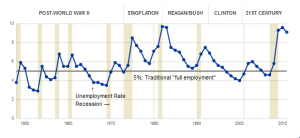 “Now that we have figures for the full four years of Obama’s first term, a surprising fact emerges: The economy added more jobs during four years under Obama than it did in the entire eight years under Bush.”
“Now that we have figures for the full four years of Obama’s first term, a surprising fact emerges: The economy added more jobs during four years under Obama than it did in the entire eight years under Bush.”
—Annenberg Fact Check
Summary
FactCheck.org closely imitates the methods of a typical misleading political campaign advertisement.
The Facts
We do not dispute the numbers FactCheck.org’s Brooks Jackson uses to support his claim about President Obama’s job creation statistics (emphasis in the original):
By the time of Obama’s second inaugural in January, the economy had added a net total of 1,208,000 jobs since he was first sworn in four years earlier, according to current figures from the Bureau of Labor Statistics. That beats George W. Bush’s eight-year total of 1,083,000.
And so far, Obama is extending his lead over Bush. Counting jobs added in February, his total now stands at a net gain of over 1.5 million jobs.
If the numbers add up then Jackson is correct. Right? What’s the problem?
Analyzing the Rhetoric
Glenn Kessler, also known as the Washington Post Fact Checker, sometimes uses a controversial rating in his fact checks: “true but false.” Kessler draws some derision for his use of the rating, but there’s something to his reasoning. Politicians routinely use true facts to support fallacious lines of reasoning. When a fact checker finds the facts in such an ad true, it may end up supporting the spurious reasoning in such an ad.
Annenberg Fact Check is effectively running that type of ad on President Obama’s behalf with its trumpeting of his job numbers.
What’s wrong with it? Let us count the ways.
Whose numbers?
FactCheck.org frames the numbers in terms of presidential responsibility. Yet fact checkers often caution against crediting responsibility to government executives. PolitiFact, for example, tweaked its grading policy to take credit and blame into account and rated one of Mr. Obama’s otherwise true jobs claims “Mostly True” because he implicitly claimed a share of the responsibility.
Ezra Klein effectively torpedoes overly crediting presidents and governors with job losses or job creation:
To buy much of this requires you to hold deeply ridiculous beliefs about the American economy. You must believe that Obama bears responsibility for events that predate his presidency and deserves applause for the demand created by aging cars and worn- down machinery. You must believe that Congress, which controls fiscal policy, and the Federal Reserve, which controls monetary policy, bear little or no responsibility for the economy, but that the president, who controls neither fiscal nor monetary policy, is the primary driver of job creation. You must believe that governors have absolute power over state economies and that global demand is irrelevant. You must also renounce belief in Christmas — or at least its influence on the consumer-driven economy.
Virtually no one really believes these things. But partisans and the news media routinely act as if they are true.
FactCheck.org should join Klein in denouncing the myth instead of effectively jumping on the partisan bandwagon. Presidents typically have little effect on job creation. President Clinton enjoyed the benefits of the dotcom bubble. The second President Bush enjoyed the benefits of a housing bubble before it popped in 2007 and put the banking system in crisis. President Obama enjoys the benefit of starting his presidency with high unemployment, leaving ample room for growth even with mediocre economic performance.
Though presidents have little to do with job creation, FactCheck.org leads off its “key statistical measures of Barack Obama’s presidency” list with job growth figures.
Apples, oranges or both?
What could be more fair than comparing presidents’ economic performance according to the objective and unbiased dates they started and finished their terms in office? It’s apples to apples, right?
It’s superficially apples to apples. But it’s more apples to oranges since the economy does not reset when a new president takes office. Bush inherited a slowing economy from Clinton, associated with the deflation of the tech bubble. Obama inherited a deep recession from Bush in turn.
At right, we have a chart from the Washington Post that helps illustrate the ironic advantage of a high unemployment rate when it comes to creating new jobs.
A high unemployment rate allows a high ceiling for new job growth. Economists consider an unemployment rate in the 5 percent range full employment. That’s because people change jobs even when the economy is very healthy. Unemployment went very high during President Reagan’s first term. That helped allow Reagan to establish a solid record for job creation. Clinton likewise inherited a relatively high unemployment figure, near 7 percent.
The top three presidents for net job creation, Clinton, Reagan and Johnson, all worked with an unemployment rate near 7 percent early during their presidencies. And each ended their time in office without experiencing significant job losses from a recession. In contrast, the top annual average unemployment rate for Bush was 6.0 percent until the recession near the end of his second term.
The evidence is clear: Measuring job creation from the start to the end of a president’s tenure counts as an essentially arbitrary time frame. It by nature fails to account for many of the most important variables that affect job growth and the economy.
Ezra Klein’s right. No serious figure takes seriously the notion that presidents exercise a large degree of control over job creation. Yet journalists often treat job growth as though it is something presidents largely control. Count Annenberg Fact Check among them on April 16, 2013. The mistake encourages readers to commit the false cause fallacy.
Don’t look to this Annenberg article to shed meaningful light on the comparison between the economic policies of Obama and Bush.
Summary
“The economy added more jobs during four years under Obama than it did in the entire eight years under Bush.”
Note:
It’s proper to point out that Annenberg Fact Check has also produced a fact check on job creation statistics that attempted to achieve an apples-to-apples comparison by measuring jobs added dating from the time the economy started to come out of recession.
References
Jackson, Brooks. “Obama’s Numbers (Quarterly Update).” FactCheck.org. The Annenberg Public Policy Center, 16 Apr. 2013. Web. 21 Apr. 2013.
Adair, Bill. “Tuning the Truth-O-Meter.” PolitiFact. Tampa Bay Times, 25 Jan. 2012. Web. 21 Apr. 2013.
Klein, Ezra. “Economists Scoff at Obama, Romney Job-Creation Myths.” Bloomberg. Bloomberg L.P., 12 Jan. 2012. Web. 21 Apr. 2013.
Sicilia, David B., Kenneth W. Smith, Jr., and Dwuan June. “A Brief History of U.S. Unemployment.” The Washington Post. The Washington Post Company, n.d. Web. 21 Apr. 2013.
Patton, Mike. “The Real Story Of Job Creation.” Forbes. Forbes Magazine, 02 Nov. 2012. Web. 21 Apr. 2013.
Kiely, Eugene, and Robert Farley. “Obama’s Economic Sleight of Hand.” FactCheck.org. The Annenberg Public Policy Center, 15 June 2012. Web. 22 Apr. 2013.






